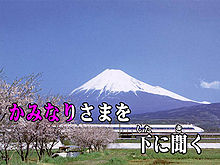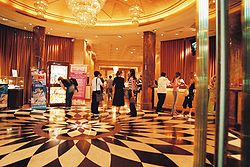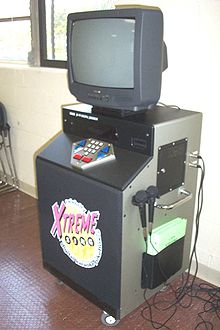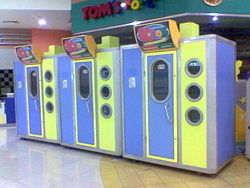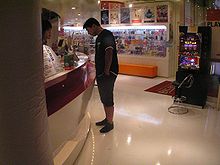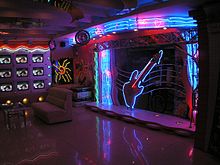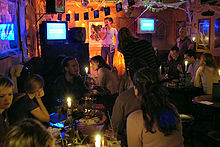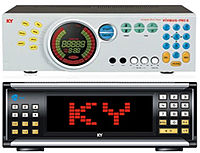- Karaoke
-
Karaoke (カラオケ, portmanteau of Japanese kara 空 "empty", and ōkesutora オーケストラ "orchestra")[1](English pronunciation: /ˌkæriːˈoʊkiː/; Japanese: [kaɽaoꜜke] (
 listen)) is a form of interactive entertainment or video game in which amateur singers sing along with recorded music (or a music video) using a microphone and public address system. The music is typically a well-known pop song minus the lead vocal. Lyrics are usually displayed on a video screen, along with a moving symbol, changing color, or music video images, to guide the singer. In some countries, a karaoke box is called a KTV. It is also a term used by recording engineers translated as "empty track" meaning there is no vocal track.
listen)) is a form of interactive entertainment or video game in which amateur singers sing along with recorded music (or a music video) using a microphone and public address system. The music is typically a well-known pop song minus the lead vocal. Lyrics are usually displayed on a video screen, along with a moving symbol, changing color, or music video images, to guide the singer. In some countries, a karaoke box is called a KTV. It is also a term used by recording engineers translated as "empty track" meaning there is no vocal track.Contents
History
The concept of creating studio recordings that lack the lead vocal has been around for nearly as long as recording itself. Many artists, amateur and professional, perform in situations where a full band/orchestra is either logistically or financially impractical, so they use a "karaoke" recording; they are, however, the original artists. (This is not to be confused with "lip synching," in which a performer mimes to a previously produced studio recording with the lead vocal intact.)
1960s: Development of audio-visual-recording devices
From 1961–1966, the American TV network NBC carried a karaoke-like series, Sing Along with Mitch, featuring host Mitch Miller and a chorus, which superimposed the lyrics to their songs near the bottom of the TV screen for home audience participation.[2] The primary difference between Karaoke and sing-along songs is the absence of the lead vocalist.
Sing-alongs (present since the beginning of singing) fundamentally changed with the introduction of new technology. In the late 1960s and into the 1970s, stored audible materials began to dominate the music recording industry and revolutionized the portability and ease of use of band and instrumental music by musicians and entertainers as the demand for entertainers increased globally. This may have been attributable to the introduction of music cassette tapes, technology that arose from the need to customize music recordings and the desire for a "handy" format that would allow fast and convenient duplication of music and thereby meet the requirements of the entertainers' lifestyles and the 'footloose' character of the entertainment industry.
1971: Development of the karaoke machine
There are various disputes about who first invented the name karaoke. One claim is that the karaoke styled machine was invented by Japanese musician Daisuke Inoue[3] in Kobe, Japan, in 1971.[4][5] After becoming popular in Japan, karaoke spread by Hideo to East and Southeast Asia during the 1980s and subsequently to other parts of the world.
In Japan, it has long been common to provide musical entertainment at a dinner or a party. Japanese drummer Daisuke Inoue was asked frequently by guests in the Utagoe Kissa, where he performed, to provide a recording of his performance so that they could sing along on a company-sponsored vacation. Realizing the potential for the market, Inoue made a tape recorder that played a song for a 100-yen coin. Instead of giving his karaoke machines away, Inoue leased them out so that stores did not have to buy new songs on their own. Originally, it was considered a somewhat expensive fad, as it lacked the live atmosphere of a real performance and 100 yen in the 1970s was the price of two typical lunches, but it caught on as a popular entertainment. Karaoke machines were initially placed in restaurants and hotel rooms; soon, new businesses called karaoke boxes, with compartmented rooms, became popular. In 2004, Daisuke Inoue was awarded the tongue-in-cheek Ig Nobel Peace Prize for inventing karaoke, "thereby providing an entirely new way for people to learn to tolerate each other."[6]
Filipino patent
Roberto del Rosario, a Filipino inventor, who developed a sing along system in 1975 and patented it in the 1980s called his sing-along system "Minus-One," now[when?] holds the patent for the device now commonly known as the "karaoke machine". Following a court battle with a Japanese company which claimed to have invented the system, del Rosario's patents were issued in 1983 and 1986, a decade after the device was supposedly invented.[7]
1990s
Karaoke soon spread to the rest of Asia and other countries all over the world. In-home karaoke machines soon followed but lacked success in the US and Canadian markets. When creators became aware of this problem, karaoke machines were no longer being sold strictly for the purpose of karaoke but as home theater systems to enhance television watching to "movie theater like quality". Home theater systems took off, and karaoke went from being the main purpose of the stereo system to a side feature.
As more music became available for karaoke machines, more people within the industry saw karaoke as a profitable form of lounge and nightclub entertainment. It is not uncommon for some bars to have karaoke performances seven nights a week, commonly with high-end sound equipment superior to the small, stand-alone consumer versions. Dance floors and lighting effects are also becoming common sights in karaoke bars. Lyrics are often displayed on multiple TV screens around the bar.
Kevin Wall is sometimes attributed with bringing Karaoke to the United States.
Second patent case
Another company filed a patent infringement case.[8] It was posthumously awarded in favour of Roberto del Rosario under G.R. No. 115106, 15 March 1996 of the Philippine Supreme Court filed on 18 January 1993.[citation needed]
Technology
A basic karaoke machine consists of a music player, microphone inputs, a means of altering the pitch of the played music, and an audio output. Some low-end machines attempt to provide vocal suppression so that one can feed regular songs into the machine and remove the voice of the original singer; however, this is rarely effective. Most common machines are CD+G, Laser Disc, VCD or DVD players with microphone inputs and an audio mixer built in. CD+G players use a special track called subcode to encode the lyrics and pictures displayed on the screen while other formats natively display both audio and video.
Most karaoke machines have technology that electronically changes the pitch of the music so that amateur singers can choose a key that is appropriate for their vocal range, while maintaining the original tempo of the song. (Old systems which used cassettes changed the pitch by altering playback speed, but none are still on the market, and their commercial use is virtually nonexistent.)
A popular game using karaoke is to type in a random number and call up a song, which participants attempt to sing. In some machines, this game is pre-programmed and may be limited to a genre so that they cannot call up an obscure national anthem that none of the participants can sing. This game has come to be called "Kamikaze Karaoke" or "Karaoke Roulette" in some parts of the United States and Canada.[citation needed]
Many low-end entertainment systems have a karaoke mode that attempts to remove the vocal track from regular audio CDs, using an Out Of Phase Stereo (OOPS) technique. This is done by center channel extraction, which exploits the fact that in most stereo recordings the vocals are in the center. This means that the voice, as part of the music, has equal volume on both stereo channels and no phase difference. To get the quasi-karaoke (mono) track, the left channel of the original audio is subtracted from the right channel. The Sega Saturn also has a "mute vocals" feature that is based on the same principle and is also able to adjust the pitch of the song to match the singer's vocal range.
This crude approach results in the often-poor performance of voice removal. Common effects are hearing the reverberation effects on the voice track (due to stereo reverb on the vocals not being in the center); also, other instruments (snare/bass drum, bass guitar and solo instruments) that happen to be mixed into the center get removed, degrading this approach to hardly more than a gimmick in those devices. Recent years have seen the development of new techniques based on the Fast Fourier Transform. Although still not perfect, the results are usually much better than the old technique, because the stereo left-right comparison can be done on individual frequencies.
Early age
Early karaoke machines used cassette tapes, but technological advances replaced this with CDs, VCDs, laserdiscs and, currently, DVDs. In the late 1980s and 1990s, Pioneer Electronics dominated the international karaoke music video market, producing high quality karaoke music videos (inspired by the music videos such as those on MTV).[citation needed]
In 1992, Taito introduced the X2000, which fetched music via a dial-up telephone network. Its repertoire of music and graphics was limited, but its smaller size and the advantage of continuous updates saw it gradually replace traditional machines. Karaoke machines which are connected via fiber-optic links enabling them to provide instant high-quality music and video are becoming increasingly popular.[citation needed]
Karaoke direct is an Internet division established in 1997 been serving the public online since 1998. They released the first karaoke player that supports MP3+G and now[when?] the KDX2000 model supporting karaoke in DIVX Format.[citation needed]
Karaoke video games
The earliest karaoke-based music video game, called Karaoke Studio, was released for the Nintendo Famicom in 1985, but its limited computing ability made for a short catalog of songs and therefore reduced replay value. As a result, karaoke games were considered little more than collector's items until they saw release in higher-capacity DVD formats.[citation needed]
Karaoke Revolution, created for the PlayStation 2 by Harmonix and released by Konami in North America in 2003, is a console game in which a single player sings along with on-screen guidance and receives a score based on his or her pitch, timing, and rhythm. The game soon spawned several follow-ups including Karaoke Revolution Vol. 2, Karaoke Revolution Vol. 3, Karaoke Revolution Party Edition, CMT Presents Karaoke Revolution: Country and Karaoke Revolution Presents: American Idol. While the original Karaoke Revolution was also eventually released for the Microsoft Xbox console in late 2004, the new online-enabled version included the ability to download additional song packs through the console's exclusive Xbox Live service.[citation needed]
A similar series, SingStar, published by Sony Computer Entertainment Europe, is particularly popular in the European and Australasian markets. Other music video game titles that involve singing by the player include Boogie and its sequel Boogie SuperStar, Disney Sing It, Get On Da Mic, Guitar Hero World Tour, High School Musical: Sing It!, Lips, the Rock Band series, SingSong, UltraStar, and Xbox Music Mixer.[citation needed]
Karaoke VCDs
Many VCD players in Southeast Asia have a built-in karaoke function. On stereo recordings, one speaker will play the music with the vocal track, and the other speaker will play the music without the vocal track. So, to sing karaoke, users play the music-only track through both speakers. In the past, there were only pop-song karaoke VCDs. Nowadays, different types of karaoke VCDs are available. Cantonese opera karaoke VCD is now a big hit among the elderly in Hong Kong.
Karaoke on mobile phones
In 2003, several companies started offering a karaoke service on mobile phones, using a Java MIDlet that runs with a text file containing the words and a MIDI file with the music. This is still a budding service, and it is unclear whether it will become popular; however, some mobile karaoke providers, such as Karaokini, have begun to achieve commercial success.
Researchers have also developed karaoke games for cell phones in order to boost music database training. In 2006, the Interactive Audio Lab at Northwestern University released a game called Karaoke Callout for the Nokia Series 60 phone. The project has since then expanded into a web-based game and will be released soon as an iPhone application.
Karaoke is now available for the iPhone and other playback devices at many internet storefronts.
Karaoke on computers and the Internet
Since 2003, much software has been released for hosting karaoke shows and playing karaoke songs on a personal computer. Instead of having to carry around hundreds of CD-Gs or laserdiscs, KJs can "rip" their entire libraries onto their hard drives and play the songs and lyrics from the computer.
Additionally, new software permits singers to sing and listen to one another over the Internet.
There are many sites that offer Karaoke on the internet, such as Youtube, where people can search for karaoke videos of popular songs[citation needed].
Karaoke in automobiles
South Korea in the 1990s had taxis with karaoke machines, or "caroke."[9]
Chinese automobile maker Geely Automobile received much press in 2003 for being the first to equip a car, their Beauty Leopard, with a karaoke machine as standard equipment. Europe's first commercial "karaokecab" which was a London TX4 taxi with a karaoke machine inside for occupants of the cab to use to sing whilst in the cab. The idea and installation were made by Richard Harfield of karaokeshop.com and was featured on Channel 4's Big Breakfast and several German TV stations featured the karaokecab. Granada TV also featured the cab, which is now in its 4th vehicle and operates in Bolton, Greater Manchester as Clint's Karaoke Cab. Karaoke is often also found as a feature in aftermarket in-car DVD players.
Karaoke is currently available in London, England in the 'Kabeoke' fleet of private hire vehicles.
Alternative playback devices
The CD+G format of a karaoke disc, which contains the lyrics on a specially encoded subcode track, has heretofore required special—and expensive—equipment to play. Commercial players have come down in price, though, and some unexpected devices (including the Sega Saturn video game console and XBMC Media Center on the Xbox 1) can decode the graphics; in fact, karaoke machines, including video and sometimes recording capability, are often popular electronics items for sale in toy stores and electronics stores.
Additionally, there is software for Windows, Pocket PC, Linux, and Macintosh PCs that can decode and display karaoke song tracks, though usually these must be ripped from the CD first, and possibly compressed.
In addition to CD+G and software-based karaoke, microphone-based karaoke players enjoy popularity mainly in North America and some Asian countries such as the Philippines. Microphone-based karaoke players only need to be connected to a TV—and in some cases to a power outlet; in other cases they run on batteries. These devices often support advanced features, such as pitch correction and special sound effects. Some companies offer karaoke content for paid download to extend the song library in microphone-based karaoke systems.
CD+G, DVD, VCD and microphone-based players are most popular for home use. Due to song selection and quality of recordings, CD+G is the most popular format for English and Spanish. It is also important to note that CD+G has limited graphical capabilities, whereas VCD and DVD usually have a moving picture or video background. VCD and DVD are the most common format for Asian singers due to music availability and largely due to the moving picture/video background.
Karaoke terms
- Jūhachiban
- (十八番. also ohako). Many karaoke singers have one song which they are especially good at and which they use to show off their singing abilities. In Japan, this is called jūhachiban in reference to Kabuki Jūhachiban, the 18 best kabuki plays.
- Karamovie or Movioke
- Karaoke using scenes from movies. Amateur actors replace their favorite movie stars in popular movies. Usually facilitated by software or remote control muting and screen blanking/freezing. Karamovie originated in 2003.
- Karaoke jockey or KJ
- A karaoke jockey plays and manages the music for a venue. The role of the KJ often includes announcing song titles and whose turn it is to use the microphone.
Hitokara
Singing karaoke alone is called hitokara (ヒトカラ, ヒト hito, "one person" or "alone" and カラ kara, "karaoke") in Japan. Recently this trend has become very popular amongst amateur singers in Japan, also India and China.
Karaoke in culture
Public places for karaoke
Asia
In Asia, a karaoke box is the most popular type of karaoke venue. A karaoke box is a small or medium-sized room containing karaoke equipment rented by the hour or half-hour, providing a more intimate atmosphere. Karaoke venues of this type are often dedicated businesses, some with multiple floors and a variety of amenities including food service, but hotels and business facilities sometimes provide karaoke boxes as well.
In some traditional Chinese restaurants, there are so-called "mahjong-karaoke rooms" where the elderly play mahjong while teenagers sing karaoke. The result is fewer complaints about boredom but more noise. Noise regulations can be an issue, especially when karaoke is brought into residential areas.
In the Philippines, karaoke machines are available for rent for use in occasions such as parties.
Violent reactions to karaoke singing have made headlines in Malaysia, Thailand and the Philippines, with reports of killings by listeners disturbed by the singing. In the Philippines, at least a half dozen killings of people singing "My Way" caused newspapers there to label the phenomenon "My Way killings"; some bars refuse to allow the song, and some singers refrain from vocalizing it among strangers.[10]
Throughout Asia, karaoke establishments are often fronts for gentlemen's clubs, where businessmen go and pay to have female hosts drink, sing, and dance with them. In China there is no difference in naming the two types of karaoke, both being called KTV, the Koreans call it NRB, and the Japanese call it piano bars.
North America and Europe
A karaoke bar, restaurant, club or lounge is a bar or restaurant that provides karaoke equipment so that people can sing publicly, sometimes on a small stage. Most of these establishments allow patrons to sing for free, with the expectation that sufficient revenue will be made selling food and drink to the singers. Less commonly, the patron wishing to sing must pay a small fee for each song they sing. Both are financially beneficial for the establishment by not having to pay a professional singer or a cabaret tax which is usually applied to any entertainment of more than 1 person.
Many establishments offer karaoke on a weekly schedule, while some have shows every night. Such establishments commonly invest more in both equipment and song discs, and are often extremely popular, with an hour or more wait between a singer's opportunities to take the stage (called the rotation).
Private karaoke rooms, similar to Asia's karaoke boxes, are commonplace in communities such as Toronto, Los Angeles and San Francisco.
Throughout much of North America, live band karaoke is also popular. With live band karaoke, singers sing with a live band instead of the prerecorded backing track.
USA's Karaoke trend begin to take light as ABC's Karaoke Battle USA hits broadcast network Summer 2011, some could say that it was due to all the singing competitions such as The Voice, American Idol, X-factor or it could be due to influences from famous sitcoms such as Glee. Regardless, Karaoke is definitely gaining popularity as one of America's favorite past times. Unlike Karaoke in Asia, this recreational activity is still a growing trend and gaining popularity predominantly among the female demographics and the gay community.
Also popular among the international performing arts community in Europe, a group of Finnish producers organized an international karaoke competition called KWC (Karaoke World Championships). Their 2011 international karaoke competition has attracted ABC producers to help host America's karaoke competition in Las Vegas Nevada called Karaoke Battle USA. The competition is promised to select 1 male and 1 female contestant to represent USA in the international arena. Largely supported by the Broadway community in Times Square, Pulse Karaoke Lounge sponsored 2011's NY state karaoke finals to select individuals representing NY in the eastern finals.
Karaoke in the Philippines
Many restaurants and bars in the Philippines, as well as Filipino restaurants and bars abroad, have karaoke machines to allow customers to sing.
Karaoke in South Korea
South Koreans generally use another term - 노래방 (Noraebang/NRB), which translates into "Song Room". Norebangs typically have a number of private rooms ranging in size from four seats to upwards of thirty.
There are usually two microphones, a book containing the names and artists of the songs, and a remote control for the karaoke machine. The remote controls allow the users to search for songs by name, artist, or country. The song selection available typically includes those from multiple languages.
In South Korea, karaoke is very popular for all ages. According to statistics collected in 2009, there are 35,684 song rooms in Korea with an average of 1.9 million people participating each day.[11]
The pricing varies dependent on the size and location of the room but the average cost ranges from around 10,000₩ to 20,000₩ per hour (1,000₩ = approx. $1 USD).
There are also "Coin Norebang" which translates into "Coin Song Room". The coin norebangs are usually used by teenagers and are usually located in Korean video arcades and can even be found on trains. Instead of paying hourly, the machines allow you to sing one song, upon your selection, with the insertion of a coin (the prices may vary from 200₩ to 500₩).
Most norebangs sell food and alcohol. Also, many adults in South Korea use the norebangs to sober up after drinking.[citation needed]
Karaoke in Taiwan
In Taiwan, karaoke bars similar to those in Japan and Korea are called KTV, short for karaoke television. The biggest KTV chain in Taiwan is Cashbox KTV.
Karaoke in Australia
In Australia, karaoke was gradually popularised in the late 1980s. A number of Filipino migrants brought with them their own 'minus-one' music from cassette music tapes and video tapes purchased mainly in the Philippines. A number of Philippine-imported karaoke units with two cassette drives were used in private households. Video TV tapes, mainly consisted of popular and contemporary songs rendered by Filipino artists, and with a mix of English and Tagalog songs were soon used. Projected lyrics on TV screens became very common as the main source of karaoke renditions. These tapes were soon replaced by CD+Gs, but a plug-n-play karaoke microphone that housed a factory built-in songchip loaded with hundreds of karaoke songs quickly became a favourite. This unit would usually be purchased in the Philippines and brought into Australia, becoming a common household item and is popularly used during gatherings.
In the mid 2000s, a number of karaoke bars sprouted in Sydney with karaoke boxes frequented by Japanese students and tourists and a few locals, especially on Thursday nights and weekends. A number of clubs such as RSL, League Clubs and restaurants and bars mainly feature karaoke nights to entice more customers and to entertain guests.
Karaoke production methods
Karaoke is very popular in Asia, and many artists distribute a karaoke track at the same time the song is released. The most common form of karaoke nowadays is released in MIDI format with on-screen lyrics on a DVD background video.
In Europe and North America, karaoke tracks are almost never done by the original artist, but are re-recorded by other musicians. The world's largest creator of Karaoke tracks, Blank Productions USA, (since 1986), produces between 40 and 60 titles per month, adding to their 25,000 title library, which is licensed to manufacturers and content providers. Karaoke companies like Stingray Digital and Chartbuster select popular songs and release soundalike tracks with lyrics synchronized, most commonly in CD+G format.
Kumyoung and TJ Media, 2 large firms based in South Korea produces digital music (MIDI) contents and manufacture computer music players for the Asian market.
Karaoke contest
Since the rise of karaoke around the world, karaoke contests have been a phenomenon that has entered main stream culture. It gives non-professional singers the opportunity to showcase their talent, win prizes, and at times allow these singers the opportunity to travel around the world. Contest participants are usually rated 50% by customer votes and 50% by judger's votes. Judging may vary depending on the venue and the level of competition. Karaoke World Championship is one of the most popular karaoke contests and has been around since 2003.
The 2011 Karaoke World Championships will take place in Killarney, Ireland in September.
Karaoke in popular culture
Karaoke has been depicted in numerous movies and television shows, including:
- Films:
- 1989 film When Harry Met Sally features a scene where Billy Crystal and Meg Ryan's characters sing "The Surrey with the Fringe on Top" from Oklahoma!
- 1989 film Black Rain
- At the start of the 1994 film Ladybird, Ladybird
- 1996 comedy The Cable Guy
- 1997 romantic comedy My Best Friend's Wedding
- 1997 Korean gangster comedy No. 3
- 1998 film Orgazmo A man is depicted singing karaoke in a sushi bar while no one else is listening, three goons come in and vandalise the bar, in the process knocking over the karaoke machine, the singer then picks it all back up and continues singing.
- Karaoke is central to the 2000 movie Duets, which features a father and daughter competing in karaoke contests
- In the 2001 film Jackpot, an aspiring singer tours karaoke bars hoping to catch his big break as a country star
- 2001 film Rush Hour 2 includes a karaoke performance by Chris Tucker, where he upstages a tone-deaf local in Hong Kong by singing Michael Jackson's "Don't Stop 'Til You Get Enough"
- 2003 film Lost in Translation features Bill Murray and Scarlett Johansson singing in a Tokyo karaoke box
- Karaoke is the central theme of The Karaoke King, a 2006 independent film
- Karaoke 2009 Malaysian indie film starring Zahiril Adzim
- 2006 film High School Musical
- 2009 film (500) Days of Summer
- Television shows:
- American television show How I Met Your Mother
- American television show Doogie Howser, M.D.
- American television show Friends Monica sings karaoke at Mike's piano bar. She mistakenly thinks they admire her singing skills, but in fact, they are staring at her very see-through shirt.
- American television show Desperate Housewives
- Charmed episode Sense and Sense Ability, from the fifth season of the series, featured Rose McGowan (as Paige) singing "Fever" at Paige's latest boyfriend's piano bar. (Earlier in the show, she lost her voice when she was up on stage.)[12]
- Several episodes of American television series Angel feature the demonic karaoke bar Caritas, whose proprietor Lorne (Andy Hallett) can read the destiny of the person singing.
- All of American actor David Boreanaz's major television roles have involved his character being assaulted (in particular, being shot at) in a karaoke bar.[13][14][15]
- Two Pints of Lager and a Packet of Crisps featured Donna singing "Chick Chick Chicken", which was made for the BBC by Zoom Entertainments, a karaoke producer based in Hull, UK.
- One episode of the American show Heroes.
- Don't Forget the Lyrics, a game show in which contestants have to sing 10 songs correctly to win $1,000,000.
- Mai HiME, the titular character Mai Tokiha is a huge fan and the series features an episode with some of the various characters singing as well.
- Azumanga Daioh, during the episode where the characters celebrate Christmas, there is a part where they go to a karaoke club. Osaka sings Time Pavement and Sakaki sings Shin wa Shoujo parashuuto.
- In the second season episode of Beverly Hills 90210, called Cardio Funk, the Peach Pit unsuccessfully ventured into karaoke, when Jim Walsh convinced Peach Pit owner Nat to buy a karaoke machine.
- Glee had an episode whereby the main character Will Shuster sings karaoke with April Rhodes. Karaoke versions of the Glee soundtrack are available on digital downloads.
- In episode 7 of Dream High, Pilsuk and Jason go to a noraebang (Korean karaoke room).
- Up All Night had an episode where Reagan and Chris are at a bar singing and getting drunk.
- Music Videos:
- The video for Tenacious D's Tribute features Jack Black and Kyle Gass recording the song inside a karaoke box, though Black rigs the box to put in his own background music.
- Selena Gomez And The Scene's music video for their sixth single, "Love You Like A Love Song" takes place in a Japanese karaoke bar.
World records
Finland holds the record for the largest number of people singing karaoke at one time, for over 80,000 people singing "Hard Rock Hallelujah" on 26 May 2006 in Helsinki after Lordi won the Eurovision Song Contest 2006.[16]
The Hungary holds the record for the longest Karaoke marathon with multiple participants for an event organised at the Honey Grill Restaurant. It lasted for 1011 hours, 1 minute, between 20 July 2011, and 31 August 2011. Each song was over 3 minutes long and the gap between songs was no longer than 30 seconds. No song was repeated in any 2 hour period.[17]
See also
- Same Language Subtitling
- Subtitling
- Closed Captioning
- Surtitles
- Live band karaoke
- Powerpoint-Karaoke
- Utagoe Kissa
- List of English words of Japanese origin
References
- ^ encyclopedia.com- 'karaoke'
- ^ Brooks, Tim; Marsh, Earle (1992), The Complete Directory to Prime Time Network TV Shows, Ballentine Books, ISBN 0-345-37792-3
- ^ Who Invented the Karaoke Machine? Events-in-Music.com
- ^ 井上大祐【カラオケ発明者】 J-ONE/INOUE Events-in-Music.com
- ^ Time 100:Daisuke Inoue, 23–30 August 1999 VOL. 154 NO. 7/8
- ^ "The 2004 Ig Nobel Prize Winners". Winners of the Ig Nobel Prize. Improbable Research. http://improbable.com/ig/winners/#ig2004. Retrieved 2009-10-17.
- ^ About:Inventors, Roberto del Rosario Accessed 6 January 2007
- ^ http://myjoaquinfamily.blogspot.com/2007/06/bert-del-rosario-is-karaoke-inventor.html
- ^ Shin, Paul (14 June 1992). Los Angeles Times. http://articles.latimes.com/1992-06-14/news/mn-805_1_o7-karaoke-taxis.
- ^ Onishi, Norimitsu, "Sinatra Song Often Strikes Deadly Chord", 7 February 2010, The New York Times, retrieved same day
- ^ http://cafe.naver.com/hpykim52.cafe?iframe_url=/ArticleRead.nhn%3Farticleid=62833&
- ^ "Charmed: Sense and Sense Ability Episode Recap". TV.com. TV.com. http://www.tv.com/charmed/sense-and-sense-ability/episode/233884/recap.html?tag=episode_recap;recap. Retrieved 23 April 2011.
- ^ Angel Episode "That Old Gang of Mine"
- ^ Angel Episode "Offspring"
- ^ Bones Episode "Wannabe in the Weeds"
- ^ "Star-studded 2007 edition of Guinness World Records released". CBC News. 29 September 2006. http://www.cbc.ca/arts/story/2006/09/29/guinness-record-book.html.[dead link]
- ^ Longest karaoke marathon by multiple participants
External links
Wikimedia Foundation. 2010.

